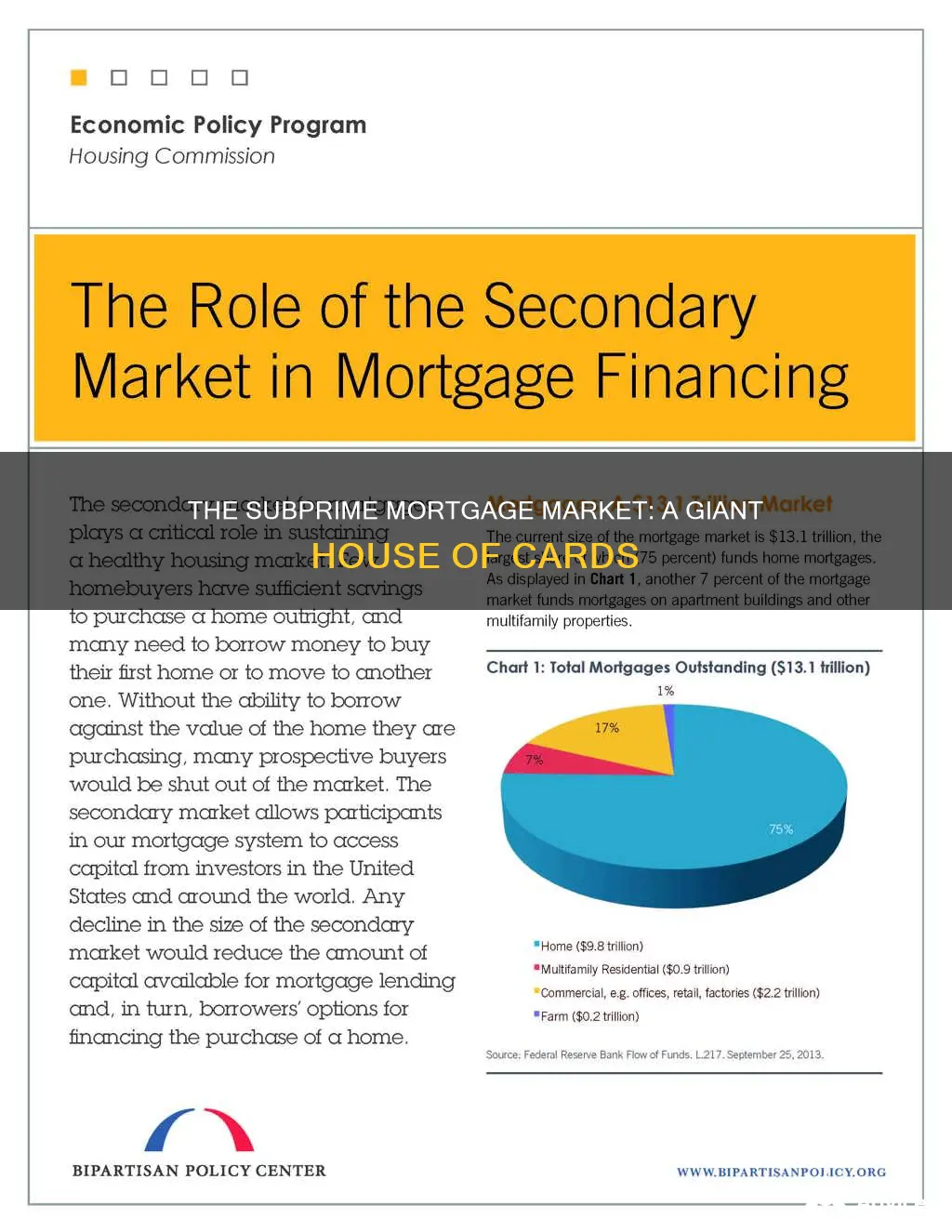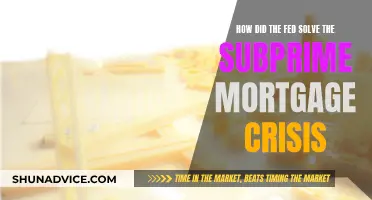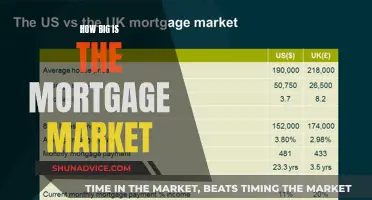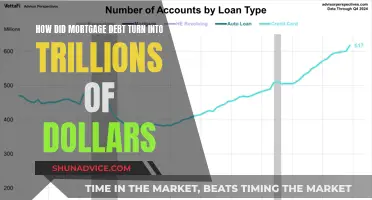
The subprime mortgage market in the US grew significantly from the mid-1990s onwards, as banks and lenders relaxed their standards to help those with low or no credit scores to take out loans. Subprime mortgages are loans with higher interest rates offered to borrowers with low credit ratings. The subprime mortgage crisis, which began in 2007, was caused by the widespread defaulting on these loans, with many borrowers unable to keep up with their payments as interest rates rose. This led to a downward spiral in house prices, as borrowers tried to sell their homes to avoid foreclosure, and resulted in the financial crisis of 2007-2008 and the subsequent Great Recession.
| Characteristics | Values |
|---|---|
| Definition | The subprime market is the business of lending money to people or businesses who are at a greater risk of defaulting on their payments. |
| Years of operation | Mid-1990s to 2007-2008 |
| % of subprime mortgages among all home loans in the US | 2.5% per year in the late 1990s to about 15% per year in 2004-2007 |
| Causes of the subprime mortgage crisis | Influx of money from the private sector, banks entering the mortgage bond market, government policies aimed at expanding homeownership, speculation by many homebuyers, and predatory lending practices of mortgage lenders |
| Culprits of the crisis | Banks with lax or no lending standards, regulators at the Federal Reserve Board and the Securities and Exchange Commission (SEC), credit agencies, and borrowers who borrowed far beyond their means |
| Losses suffered by government-sponsored enterprises | Fannie Mae and Freddie Mac |
| Impact on the economy | Lowered construction, reduced wealth and consumer spending, decreased the ability of financial firms to lend, and reduced the ability of firms to raise funds from securities markets |
| Types of subprime mortgage contracts | Adjustable-rate mortgage (ARM) |

Subprime mortgage crisis
The subprime mortgage crisis was a period of financial turmoil that occurred between 2007 and 2010. It was caused by a combination of factors, including the influx of money from the private sector, banks entering the mortgage bond market, and government policies aimed at expanding homeownership. In the early to mid-2000s, lending standards relaxed, and high-risk mortgages became available to borrowers who typically would not have qualified for traditional loans. These subprime loans were given to borrowers with lower credit scores and often carried higher interest rates.
The expansion of mortgages to high-risk borrowers, coupled with rising house prices, contributed to the period of turmoil in financial markets. As interest rates rose and access to credit became more difficult, many homeowners faced mortgages they could no longer afford, leading to a sharp increase in high-risk mortgage defaults. This was further exacerbated by speculation from homebuyers and the predatory lending practices of mortgage lenders, who sold adjustable-rate mortgages and 2–28 loans.
The crisis was also influenced by new financial products, such as private-label mortgage-backed securities (PMBS), which provided most of the funding for subprime mortgages. These securities were viewed as low risk because they were insured with new financial instruments or because other securities would absorb any losses on the underlying mortgages. This enabled more first-time homebuyers to obtain mortgages, driving up demand and house prices. However, when high-risk borrowers could not make loan payments, investors began to suffer losses, leading to a cascading crisis.
The collapse of subprime lending fueled a downward spiral in house prices, hurting the overall economy. It lowered construction, reduced wealth and consumer spending, decreased the ability of financial firms to lend, and hindered firms' ability to raise funds from securities markets. The crisis led to mass foreclosures, the devaluation of housing-related securities, and a severe economic recession, with millions losing their jobs and many businesses going bankrupt.
Freedom Mortgage: A Giant in the Industry
You may want to see also

Subprime lending
In the United States, the subprime market existed on the fringes until the mid-1990s, when established banks and lenders realised the potential for profit from relaxing their lending standards. Lenders were attracted by the prospect of higher interest margins and the opportunity to package and sell their loans in bulk to institutional investors. This practice became particularly attractive following the introduction of new financial products, such as private-label mortgage-backed securities (PMBS), which provided most of the funding for subprime mortgages.
The subprime mortgage crisis arose from "bundling" American subprime and regular mortgages into mortgage-backed securities (MBSs) that were traditionally isolated from, and sold separately to, prime loans. These "bundles" of mixed mortgages were based on asset-backed securities, so the probable rate of return looked very good, as it was assumed that the real estate they were secured against could not lose value. Many subprime mortgages had low initial interest rates for the first two or three years, and those who defaulted were initially 'swapped' for new borrowers. However, a bigger share of borrowers than expected began to default in staggering numbers. The inflated house-price bubble burst, property valuations plummeted, and the real rate of return on investment could not be estimated, so confidence in these instruments collapsed, and all less-than-prime mortgages were considered almost worthless.
The subprime crisis was catalysed by an influx of money from the private sector, banks entering the mortgage bond market, government policies aimed at expanding homeownership, speculation by many home buyers, and the predatory lending practices of mortgage lenders. The Financial Crisis Inquiry Commission (FCIC) concluded that the "failures" of the Big Three rating agencies were "essential cogs in the wheel of financial destruction". As of 2010, investigations of these rating agencies were still in their early stages.
The Giant Movement Mortgage: How Big Is It?
You may want to see also

Default rates
The subprime mortgage market is the business of lending money to people or businesses who are at a greater risk of defaulting on their payments. While subprime mortgages only account for about one-quarter of the total outstanding mortgages in the United States, default rates on these loans are significantly higher than on prime loans.
For example, among prime loans made in 2005, 2.2% were 60 days or more overdue 12 months after the loan was made. For subprime loans made in the same year, the percentage of defaults after 12 months was 14.6%. This figure rose to 20.5% for subprime loans made in 2006, and 21.9% for loans made in 2007.
The high default rates in the subprime market can be attributed to several factors, including predatory lending practices, easy credit, and a belief that house prices would continue to appreciate indefinitely. Many subprime borrowers were enticed by adjustable-rate mortgages that offered below-market interest rates for a predetermined period, followed by market interest rates for the remainder of the mortgage term. As a result, borrowers who could not afford the higher payments once the initial grace period ended found themselves unable to refinance and began to default.
In response to the rising level of delinquencies, lending institutions have tightened credit and underwriting standards, and subprime securities originations have slowed. These measures, along with better disclosure by lenders, efforts to prevent lending fraud and abuse, and financial counseling for borrowers, are intended to help manage financial obligations and reduce delinquency rates.
Monthly Mortgage: How Much Should You Be Spending?
You may want to see also

Credit risk
The subprime mortgage market was characterised by higher interest rates, poor-quality collateral, and less favourable loan terms. Lenders offered these loans to borrowers with lower credit ratings, who were often granted loans they could not afford. The interest rates on subprime loans were typically variable, starting low and increasing over time, making it challenging for borrowers to keep up with the payments. This was further exacerbated by the aggressive marketing tactics of mortgage brokers, who were incentivised by commissions based on the quantity of loan contracts sold, rather than their quality.
The bundling of subprime mortgages with regular mortgages into mortgage-backed securities (MBSs) was a significant contributor to the financial crisis of 2007-2009. The bundling of these loans made it difficult to assess the true risk of the investment, as the higher-risk subprime loans were mixed with lower-risk prime loans. As a result, investors and rating agencies struggled to accurately evaluate the risk of these bundled securities.
The originate-to-distribute model followed by many subprime mortgage lenders further exacerbated the credit risk. This model involved distributing loans to third-party investors, which reduced the incentive for lenders to monitor credit quality or address issues with troubled loans. As a result, there was little effort to remediate these loans when borrowers began to default.
The subprime mortgage crisis had far-reaching consequences, leading to a downward spiral in house prices and negatively impacting the overall economy. It lowered construction activity, reduced consumer spending, decreased the ability of financial firms to lend, and hindered firms' ability to raise funds from securities markets. The crisis also highlighted the need for improved regulation and oversight to mitigate credit risk and protect investors.
Gateway Mortgage: A Giant in the Industry
You may want to see also

Financial crisis
The subprime mortgage market in the US grew significantly from the mid-1990s onwards. This growth was driven by banks and lenders relaxing their standards to help those with low or no credit scores to secure loans. Lenders were drawn to higher interest margins and the ability to package and sell their loans in bulk to institutional investors.
The subprime mortgage crisis arose from the "bundling" of subprime and regular mortgages into mortgage-backed securities (MBSs) that were sold in a separate market from prime loans. These "bundles" of mortgages were based on asset-backed securities, so the probable rate of return looked very good, as it was assumed that the real estate market could not fail. Many subprime mortgages had low initial interest rates for the first two or three years, but these rates could increase by 4% or more annually thereafter. As a result, a bigger share of borrowers began to default in staggering numbers.
The inflated housing bubble burst, property valuations plummeted, and the real rate of return on investment could not be estimated, so confidence in these instruments collapsed. This induced a downward spiral in house prices, unwinding much of the increases seen in the subprime boom. As house prices plateaued, many subprime borrowers found themselves with houses they could not sell and mortgages they could no longer afford. This collapse in subprime lending fuelled the recession of 2007-2009 by hurting the overall economy in several major ways. It lowered construction, reduced wealth and, therefore, consumer spending, decreased the ability of financial firms to lend, and reduced the ability of firms to raise funds from securities markets.
The Financial Crisis Inquiry Commission (FCIC) concluded that the failures of the Big Three rating agencies were essential cogs in the wheel of financial destruction and key enablers of the financial meltdown. As of 2010, investigations of these rating agencies were still in their early stages. In New York, state prosecutors were examining whether eight banks duped credit ratings agencies into inflating the grades of subprime-linked investments.
Trump Tower NYC: Mortgage and Magnificence
You may want to see also
Frequently asked questions
The subprime mortgage market in the US grew significantly in the early to mid-2000s, with the share of subprime mortgages among all home loans in the country increasing from 2.5% per year in the late 1990s to about 15% per year in 2004-2007.
The growth of the subprime mortgage market was fuelled by aggressive marketing by mortgage brokers who were paid commissions based on the quantity of loan contracts sold, the influx of money from the private sector, and government policies aimed at expanding homeownership.
The subprime mortgage market was a key factor in the financial crisis of 2007-2009. The bundling of subprime mortgages into mortgage-backed securities (MBS) and the subsequent default by borrowers led to a collapse in confidence in these financial instruments. This, combined with the downward spiral in house prices, contributed to the economic recession.







